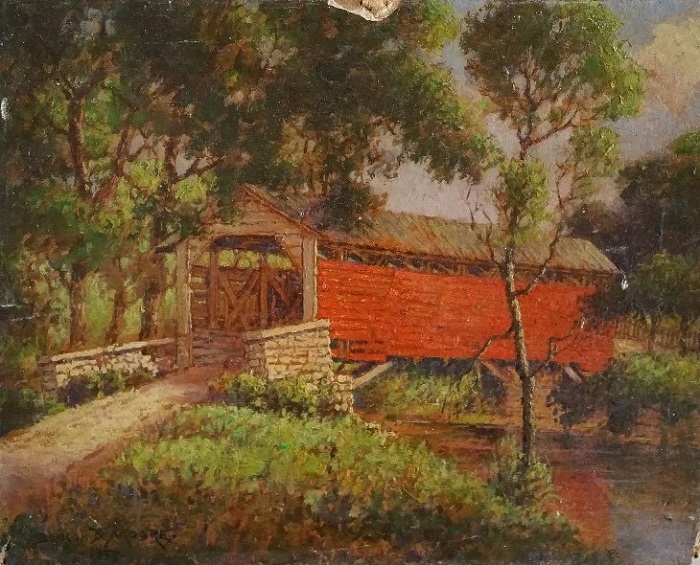
oil on board, 8 x 10
Covered Bridge by Benson Bond Moore
Benson Bond Moore, a distinguished landscape and animal-portrait painter, as well as an etcher, was born in Washington DC and spent seventy years of his life there. His artistic journey began with a Barbizon School influence, but over time, he transitioned to a more Impressionist and less Tonalist style, gaining recognition for his particularly popular snow scenes.
Growing up in an artistic environment, Moore learned framing and restoration from his father, who provided these services for prominent political figures in the nation’s capital.
Benson’s artistic education included studying at the Linthicum Institute and the Corcoran School of Art under the guidance of notable late-nineteenth century landscape school instructors, such as Edmund Messer, Richard Brooke, and Max Weyl.
In 1902, Moore joined the Maurice Joyce Photo-Engraving Company in Washington D.C., where he collaborated with Dr. Alexander Graham Bell, contributing drawings for the development of hearing aids for the deaf. His drawings were also utilized by Dr. Emile Berliner, the inventor of the graphophone, and the Smithsonian. Moore shared his expertise by teaching etching both privately and at Clara Hill’s art school.
Together with Charles Seaton, Winfield Clime, and Edwin Cassedy, Benson became a founding member of “The Ramblers Sketch Club,” an informal group of Washington painters. This group eventually evolved into the esteemed Washington Landscape Club in 1920, where Moore frequently exhibited alongside prominent artists.
Benson Bond Moore was a member of over forty arts organizations and played a pivotal role as a founding member of The Miniature Painters, Sculptors, and Gravers Society of Washington D.C., holding its inaugural exhibition at the Corcoran in 1931. His artistic achievements included numerous one-man shows, notably at the Corcoran Gallery in 1928, featuring his etchings, drypoints, and lithographs.
His lifelong passion for sketching animals, often observed at the National Zoo since childhood, led to over 3700 illustrations for “The Evening Star’s” series titled “Nature’s Children.” Additionally, Moore contributed paintings to the Smithsonian’s “Scientific Series.”
Engaging in extensive restoration work, including pieces by Thomas Moran and artworks in the Capitol rotunda, occupied Moore primarily from the 1940s. In the early 1950s, following his wife’s passing, he relocated to Sarasota, Florida, where his sister-in-law cared for him as his eyesight diminished. Despite these challenges, Moore continued to paint until his passing on November 1, 1974.
Source: Stephanie A. Strass. Curator in Hagerstown, Maryland for the Washington County Museum of Fine Arts